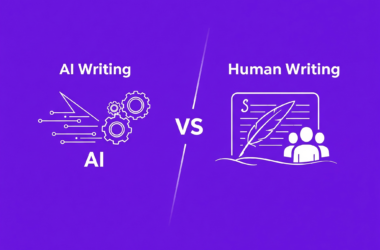Every quarter, your backlog of content ideas grows faster than your headcount.
Content marketing budgets in 2025 are mostly flat; 41% of B2B marketers expect no change, while 46% predict only modest increases (source). The mandate is clear: do more with what you already have.
The right platform makes that possible. Instead of bouncing between endless docs, spreadsheets, and browser tabs, your team lives in one workspace, gets instant SEO and brand voice feedback, routes tasks for quick approvals, and watches performance roll up to pipeline metrics — eliminating version chaos, approval bottlenecks, and guesswork reporting.
In this comprehensive guide, we’ll go through the best content marketing software options available on the market. Whether you run a startup blog or manage an enterprise content engine, the insights ahead can help you make the right buying decision faster.
1. Wittypen – The AI‑Native Content Marketing Platform
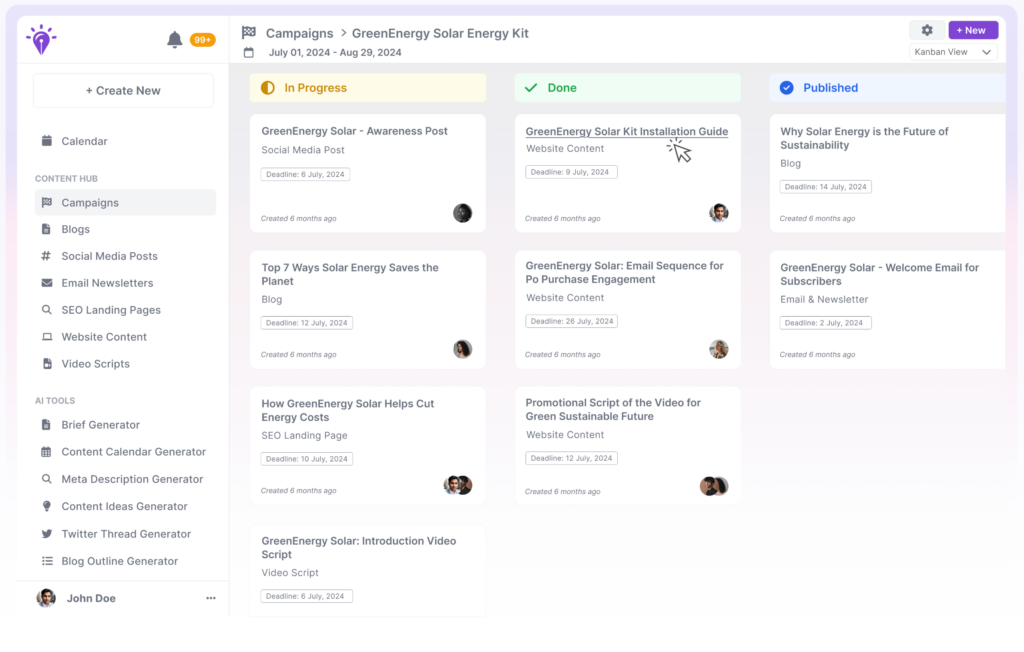
Wittypen is the modern command center where high‑growth teams plan, create, publish, and measure content in one place—faster and smarter than legacy suites.
AI‑Driven Content Planning & Topic Discovery
Generate data‑backed content calendars in seconds. The AI Content Planner mines SERPs, competitor gaps, and buyer intent, automatically mapping topics to funnel stages and applying your brand voice to every brief.
Campaign & Workflow Management
Replace spreadsheets with Kanban boards, Gantt timelines, and role‑based approvals. Deadlines, dependencies, and workload balancing keep writers, designers, and stakeholders synced at a glance.
AI Writing & Brand Style Enforcement
Draft long‑form blogs, LinkedIn threads, X/Twitter posts, video scripts, newsletters, and more from a single prompt. Brand‑style rules, tone guidelines, and contextual file uploads ensure every word sounds like you.
SEO, Quality Assurance & Multichannel Publishing
Built-in keyword research, real-time SEO scoring, grammar refinement, originality detection, and plagiarism checks ensure every asset is search-ready and brand-safe. When it’s time to ship, one-click publishing pushes content to WordPress, Webflow, HubSpot, Shopify, Marketo, and major social media platforms, keeping metadata consistent across all channels.
Performance Analytics & ROI Dashboards
Native integrations with Google Analytics 4, Google Search Console, and leading CRMs turn traffic and conversion data into live dashboards. Instantly see which keywords, formats, and channels drive pipeline and revenue.
Managed Marketplace & On‑Demand Talent
Access a curated bench of specialist writers and editors without the hiring hustle. Wittypen’s operations and editorial teams match talent to briefs, oversee revisions, and ensure each deliverable lands polished and on time, so you can stay focused on strategy, not staffing.
Free trial: Generate your first AI‑powered content brief in under 60 seconds—Start with Wittypen.
2. HubSpot Content Hub
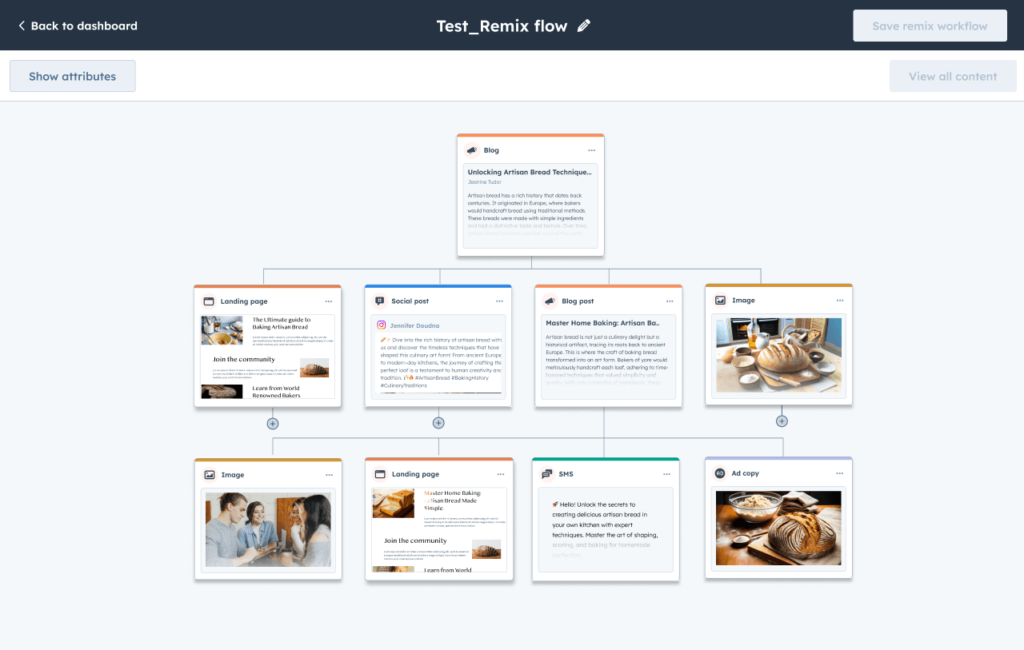
HubSpot rebranded its CMS Hub to Content Hub, bringing creation, distribution, and measurement into one workspace. Because it sits on the same database as HubSpot CRM, every blog post, landing page, and social snippet automatically inherits contact and lifecycle data, making it easy to track how content fuels pipeline and revenue.
Inside the editor, Breeze Copilot drafts first‑pass copy, translates articles into 25‑plus languages, and adapts tone with Brand Voice. The built‑in SEO tool lists on‑page fixes, such as keyword placement, meta tags, and image alt text, in priority order, while the topic‑cluster planner suggests related subtopics so you can organise content around core themes that search engines reward.
Campaign calendars, A/B testing, and Smart Content personalization help refine performance over time. Built-in video hosting, podcast syndication, and over 1,800 marketplace integrations extend reach without additional plugins.
3. Upland Kapost
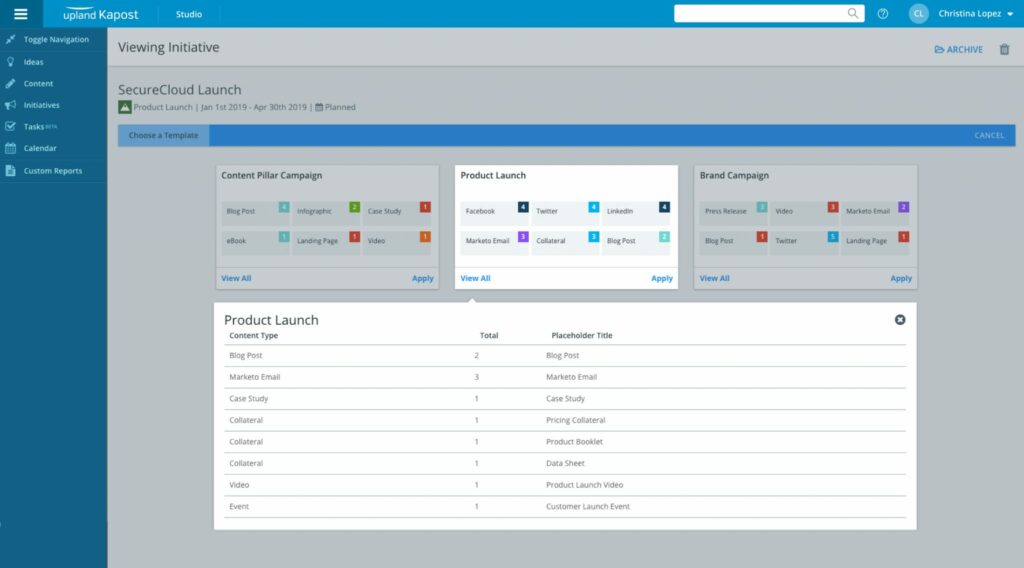
Kapost is a content operations platform built for B2B marketing teams, uniting planning, production, distribution, and performance tracking in a single workspace for easier campaign alignment and measurement.
Its unified calendar ties every asset to a persona and buying stage, while configurable workflows assign tasks, due dates, and approvals. Metadata tags, such as persona, funnel stage, and product line, keep files searchable and on brand, and in-platform reviews replace long email threads. Everything updates in real time.
Once approved, assets are published from the Kapost Content Gallery to Salesforce, Marketo, leading content management systems (CMS), and digital asset managers. Dashboards present pipeline and engagement metrics by asset, persona, and channel, and a taxonomy builder flags gaps or duplicates. Role‑based permissions and audit trails add governance without slowing teams, making Kapost suitable for large, distributed organizations.
4. Optimizely
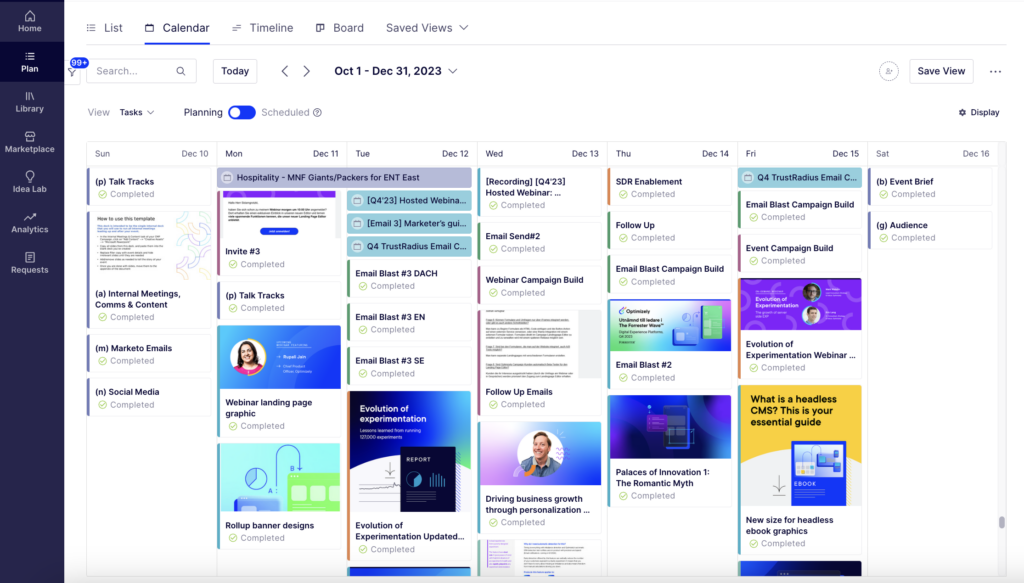
Optimizely’s Content Marketing Platform gives teams a unified workspace for editorial calendars, campaign planning, and on-brand asset production. Generative AI assistance via “Opal” speeds briefs, outlines, and metadata, while a built-in digital asset library keeps approved visuals organized for reuse.
Task boards, customizable workflows, and in-context comments align writers, designers, and stakeholders through each review stage. After approval, marketers schedule or publish directly to Optimizely CMS, WordPress, or Drupal through native connectors. Social channels like Facebook, LinkedIn, and X receive posts via feed integrations from the same interface.
A performance dashboard visualizes page views, engagement, and workflow efficiency, helping teams refine topics and prove the return on content. Role-based permissions, version history, and structured approval paths support brand governance and compliance without slowing delivery. Together, these capabilities keep strategy, creation, distribution, and insight in one reliable hub.
5. Contently
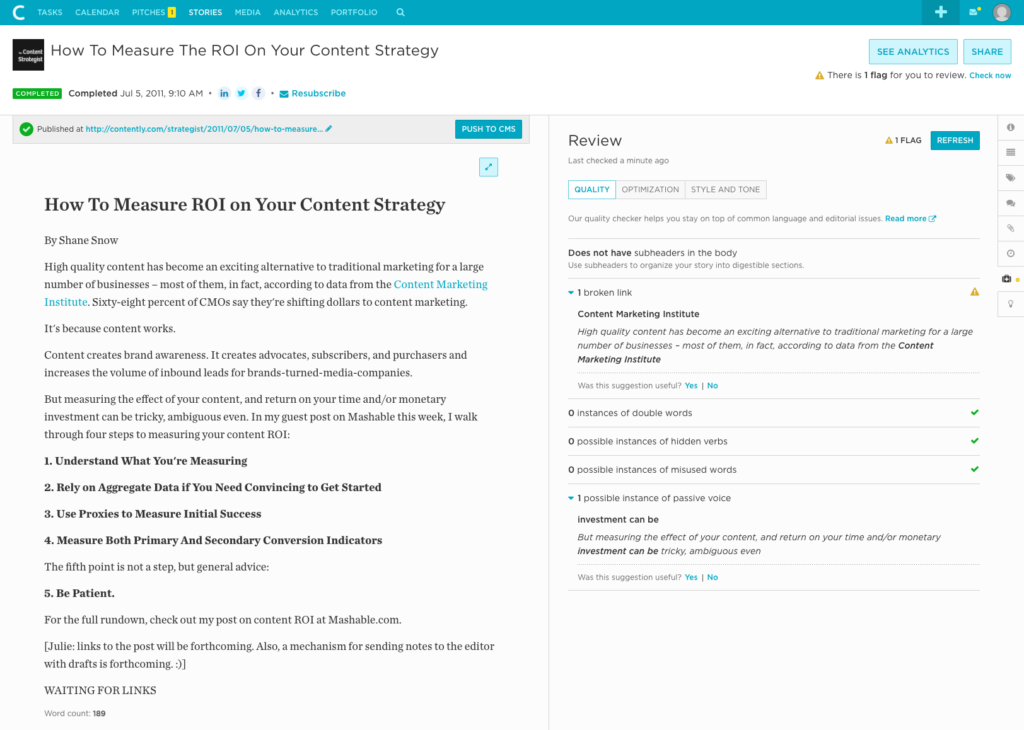
Contently brings strategy and production into one workspace. Teams outline personas, set goals, and organize stories on a color-coded calendar. A marketplace of over 160,000 freelance writers, designers, and videographers lets managers commission assets matched to brief and industry.
Custom workflows can help move drafts through legal, compliance, and editorial teams. Built-in commenting and version history keep edits organized. Approved content publishes directly to CMS, social, and CRM systems using native integrations or Zapier, preserving tags and metadata.
The Analytics Suite tracks engagement and conversions at the story and campaign levels. The Content Value Tracker converts organic traffic into an equivalent paid media dollar figure. Governance tools enforce tone, SEO, and disclosure requirements before content is published. These features and safeguards give teams confidence to scale successful programs.
What is Content Marketing Software?
Content marketing software is the control room where ideas turn into revenue‑generating assets. Instead of juggling browser tabs and rogue spreadsheets, your team ideates, writes, designs, publishes, and measures—all in one purpose‑built workspace. The best platforms in 2025 are AI-native, SEO-savvy, and integrated with the rest of your stack (GA4, GSC, WordPress, HubSpot, and Social media). Every post moves the metric that matters most.
Core jobs to be done:
- Plan editorial calendars that map directly to personas and funnel stages.
- Collaborate with version control, brand guardrails, and role‑based approvals.
- Publish to web, email, and social with a single click, keeping metadata and tracking intact.
- Prove impact by tying each asset to traffic, pipeline, and revenue—no spreadsheet gymnastics required.
Why Your Team Needs Content Marketing Software
Manual content ops are the silent budget leak. Missed deadlines, off‑brand copy, and “who has the latest version?” Slack threads drain momentum and hide ROI. Dedicated software fixes that by:
- Automating grunt work: Templated briefs, AI outlines, and auto‑scheduling free your team to think, not chase status updates.
- Enforcing consistency: Brand-voice rules and SEO checks run in real-time, so every asset sounds like your brand and something search engines like.
- Making performance obvious: Dashboards connect impressions to MQLs and closed‑won deals, giving you data to defend spend or prove you don’t need more.
According to the 2025 CMI Benchmark Report, only 26% of respondents believe their organization has the right technology to manage content across the business. There’s clearly a gap between what marketers need and what they have, and picking the right software is what can bridge that gap.
How to Choose the Best Content Marketing Software
Not all platforms are built the same. Use this checklist to evaluate the right fit for your team:
| Feature / Capability | Why It Matters in 2025 |
|---|---|
| AI‑Driven Planning | Speeds up topic discovery and aligns content to funnel stages |
| SEO Integration | Ensures content is optimized before publishing |
| Campaign & Workflow Management | Keeps teams aligned, reduces bottlenecks |
| Content Briefing & Creation Tools | Standardizes output and enforces brand consistency |
| Multichannel Publishing | Saves time and keeps messaging consistent across platforms |
| Performance Tracking & ROI Dashboards | Proves what’s working and guides future strategy |
| Collaboration & Governance | Supports cross-functional teams and maintains compliance |
| Scalability & Ease of Use | Grows with your team without slowing you down |
| On‑Demand Talent Access | Extends your team without the hassle of hiring |
Conclusion
In 2025, content teams are expected to produce more with fewer resources, and the right software makes that possible. From campaign planning and SEO to publishing and performance tracking, your tools should simplify the work, not slow down your team. Whether you’re leading a small startup team or managing a complex enterprise operation, the checklist above can help you find a platform that fits your goals, keeps your workflow organized, and makes your results easier to measure.
Wittypen checks every box above, making it the most complete, AI-native content marketing software in 2025. Whether you’re scaling content with a small team or managing complex enterprise workflows, Wittypen gives you the tools to do it all faster, smarter, and with measurable impact. Learn more or sign up for a free account



